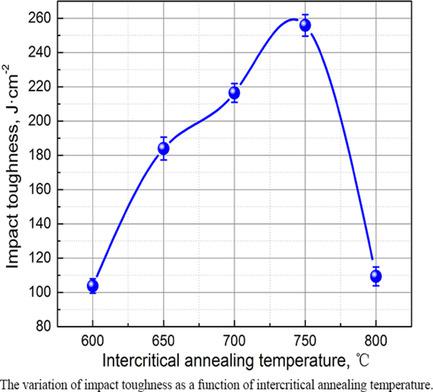当前位置:
X-MOL 学术
›
Steel Res. Int.
›
论文详情
Our official English website, www.x-mol.net, welcomes your
feedback! (Note: you will need to create a separate account there.)
The Significance of Microstructure Evolution on Governing Impact Toughness of Fe–0.2C–8.5Mn–3Al Medium‐Mn TRIP Steel Studied by a Novel Heat Treatment
Steel Research International ( IF 1.9 ) Pub Date : 2020-05-14 , DOI: 10.1002/srin.202000029 Zhichao Li 1 , Yanjie Mou 1 , Xinjing Li 1 , Devesh Misra 2 , Hua Ding 3 , Lianfang He 1 , Huiping Li 1
Steel Research International ( IF 1.9 ) Pub Date : 2020-05-14 , DOI: 10.1002/srin.202000029 Zhichao Li 1 , Yanjie Mou 1 , Xinjing Li 1 , Devesh Misra 2 , Hua Ding 3 , Lianfang He 1 , Huiping Li 1
Affiliation

|
Herein, the continuing challenge and scientific gap in obtaining high‐impact toughness in medium‐Mn steels are discussed. While addressing the challenge, the objective of the study described herein is to obtain a fundamental understanding via critical experimental analysis of the reasons underlying high‐impact toughness that is successfully obtained in Fe–0.2C–8.5Mn–3Al medium‐Mn transformation induced plasticity (TRIP) steel. This is enabled by a novel and effective heat treatment involving the combination of intercritical hardening and tempering to obtain high‐impact toughness. Electron microscopy and X‐ray diffraction studies clearly underscore the absence of TRIP effect in Fe–0.2C–8.5Mn–3Al medium‐Mn steel during impact and the volume fraction of austenite plays a determining role in governing impact toughness. The highest impact toughness of 255.96 J cm−2 is obtained when the steel is subjected to intercritical hardening temperature of 750 °C and low tempering temperature of 200 °C. The presence of martensite in the microstructure reduces the impact toughness on quenching from 800 °C. The fracture mode is ductile after intercritical hardening in the temperature range of 600–750 °C.
中文翻译:

新型热处理研究Fe–0.2C–8.5Mn–3Al中Mn TRIP钢组织演变对控制冲击韧度的意义
本文讨论了在中锰钢中获得高冲击韧性的持续挑战和科学差距。在解决挑战的同时,本文所述研究的目的是通过关键实验分析来获得对Fe–0.2C–8.5Mn–3Al中–Mn转变诱导塑性可成功获得高冲击韧性的根本原因的基本理解(TRIP)钢。通过新颖有效的热处理,包括临界间硬化和回火的结合,可以获得高冲击韧性,从而实现了这一目标。电子显微镜和X射线衍射研究清楚地表明了Fe–0.2C–8.5Mn–3Al–3Mn中锰钢在冲击过程中不存在TRIP效应,奥氏体的体积分数在决定冲击韧性方面起着决定性的作用。当钢经受750°C的临界淬火温度和200°C的低回火温度时,得到−2。从800℃开始,显微组织中马氏体的存在降低了淬火的冲击韧性。在600–750°C的温度范围内进行临界硬化后,断裂模式是延性的。
更新日期:2020-05-14
中文翻译:

新型热处理研究Fe–0.2C–8.5Mn–3Al中Mn TRIP钢组织演变对控制冲击韧度的意义
本文讨论了在中锰钢中获得高冲击韧性的持续挑战和科学差距。在解决挑战的同时,本文所述研究的目的是通过关键实验分析来获得对Fe–0.2C–8.5Mn–3Al中–Mn转变诱导塑性可成功获得高冲击韧性的根本原因的基本理解(TRIP)钢。通过新颖有效的热处理,包括临界间硬化和回火的结合,可以获得高冲击韧性,从而实现了这一目标。电子显微镜和X射线衍射研究清楚地表明了Fe–0.2C–8.5Mn–3Al–3Mn中锰钢在冲击过程中不存在TRIP效应,奥氏体的体积分数在决定冲击韧性方面起着决定性的作用。当钢经受750°C的临界淬火温度和200°C的低回火温度时,得到−2。从800℃开始,显微组织中马氏体的存在降低了淬火的冲击韧性。在600–750°C的温度范围内进行临界硬化后,断裂模式是延性的。











































 京公网安备 11010802027423号
京公网安备 11010802027423号